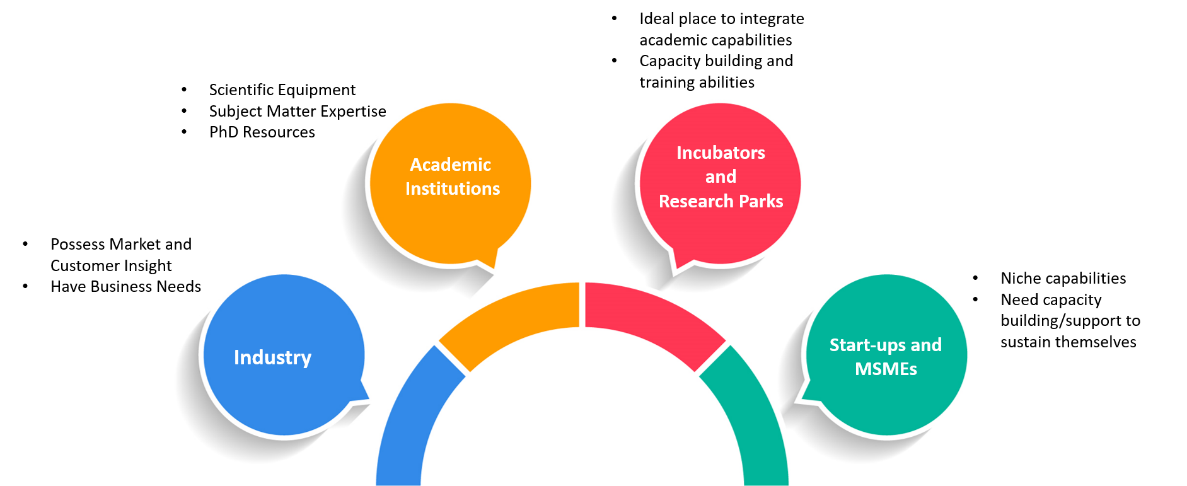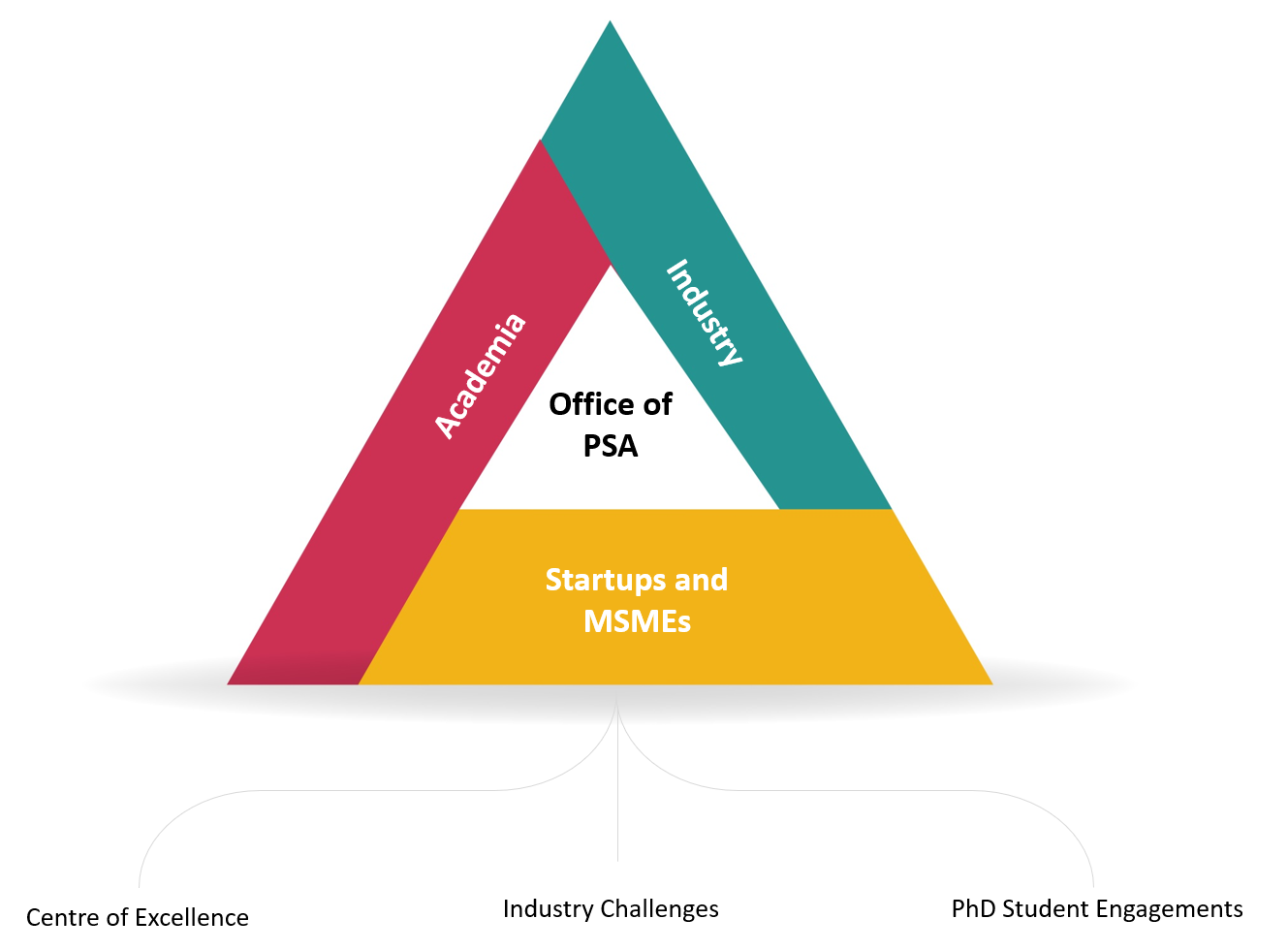
- A+
- A
- A-
Opportunities for collaboration with Office of the Principal Scientific Adviser, Government of India on Industry led Science & Technologies Cluster development
Background and Context
The COVID 19 pandemic has brought to fore the huge dependency on imports India has currently and its challenges due to broken supply chains. These realizations have led to taking steps that will enable us to gradually move towards self-reliance. This would entail roles for several stakeholders including Industry, Academia/research institutes, their incubated startups, other startup ecosystem etc. Import substitution requires a lot of innovative thinking and innovations to come out of the labs of academia as well as through Research and Development efforts of Industry.
A review of the current ecosystem of science and technology interactions between the Indian industry, academia, start-ups and MSMEs indicates several gaps that need to be plugged to realize a vibrant, effective and thriving system that can support India’s social and economic development. The industry members are the ones that are best placed to identify the problems and challenges in the society.
Currently the industry members work with individual academic institutes and mostly reach out to those that are geographically close or known to them to derive solutions to challenging problems. Further, the academic institutes also work in silos, many of them do not collaborate nor do they utilize the strengths of each other in trying to solve the industry sought problems. Equipment, subject matter expertise, PhD students and the rich knowledge in these institutes of eminence is not shared between each other.
It is a similar scenario with Indian start-ups and MSMEs. They possess niche and deep skills, but do not have the access to opportunities to apply their skills to solve challenges. These limitations also hinder their sustenance and growth prospects. The national incubators and research parks established at some of the institutes of eminence are the ideal place to channelize the academic capabilities effectively to solve industry problems by leveraging the startups and MSMEs incubated under their guidance.
While this approach is being pursued in the country, a majority of the startups and MSMEs currently are today out of their ambit and do not receive formal capacity building. To alleviate these challenges, working in a cluster mode is essential to reduce duplication of efforts and to leverage the strengths of each other.

Industry led Science & Technologies Cluster development
The office of the Principal Scientific Adviser to the Government of India is proposing a facilitation process to develop these Science and Technologies Innovation clusters to work closely with Industry, Academia and MSMEs/Startups. This would also ensure capacity building of MSME sector. The end result of such collaborations should be to utilize each other’s strengths to be able to develop technologies or provide scientific solutions for Social Development/National Missions. The industry in collaboration with academia and MSMEs/startups can develop new products and offerings. The academia will get an opportunity to further the research in key areas as part of addressing the industry problems. Startups and MSMEs also get to participate in providing solutions to the above challenges which would enable their growth and capacity building. The country would ultimately benefit from this process by synergizing the combined strengths of these three pillars to address challenges in agriculture, water, waste management and other key areas.
The proposed facilitation process opens up many possibilities of collaborations and partnerships. The industry-academia collaboration would support joint R&D and contracted R&D efforts to create new products (up to prototype stage). It will also facilitate coming together of more than one academic institution to solve the industry problem, leading to a model of industry-academia collaboration with a cluster of institutes. Involving the MSMEs and startups for component development and/or product manufacturing to address the industry problems by the industry-academia consortium would also result in capacity building of MSMEs/startups. Further, this will lead to new innovations resulting on account of cluster development through industry-academia and MSMEs/startups.
The other possible structures for collaboration are the establishment of Centers of Excellence by either the industry or academia. Industry can set up a Centre of Excellence (CoE) in any academic institute or break it into smaller CoEs in different institutes to further the R&D and promote innovations using sophisticated equipment and lab facilities.
This collaborative structure can also be leveraged to obtain innovative solutions for social development. Science and technologies are key for social impact in areas such as Water, Waste management, Agriculture, Air pollution etc. Industries can share challenges/hackathons/problem statements with academic institutes and their incubated startups to develop and produce technologies. Further, existing prototypes or products of these startups and those in the labs can also be collated and utilized by Industry.
All the above activities will also benefit the PhD students who would contribute to the above projects through research projects or special internships provided to work on solving the industry defined problems. As the facilitation process evolves, the entire PhD student community in the country across disciplines can be integrated on a unified platform – which the industry and academia can tap to help and resolve the specific challenges.
Intended Process for Collaboration
An indicative process that describes the facilitation process by the Office of the PSA, Government of India is detailed as below:
- To begin with, Industry partners would share the R&D or the new product problem statement or request for setting up of CoE on any emerging technology with the Office of the PSA, GoI.
- Upon receiving a new R&D/product problem, the Communication team at the Office of PSA, GoI would share the challenge (details of the problem) with all Science and Technologies clusters, Institutes of Eminence, National Incubators, Startup India, AGNI Invest India, Atal Incubators.
- The interested academic institution(s) [individually or collectively] and/or MSMEs and startups can then provide a proposal/approach on how they would work to solve the identified problem.
- The Office of the PSA, GoI would collate the proposals and share the same with the Industry partner. It can also help the Industry in getting an independent market assessment done by experts in the domain, to help the industry make the decision on whether to fund the academic institute for the product/prototype development or whether it is more feasible for inhouse execution.
- Upon identification of the best route/path to proceed, the selected academic institute and Industry to undertake an MoU and execute the project until prototype stage. If the optimal path necessitates a requirement of a supply chain outside of the Industry, the consortium of Institute and Industry can jointly hand pick the MSMEs or start-ups to fulfill the requirements.
- Execution of the project under the MoU will be monitored by the Office of PSA, GoI to ensure the production of required outcomes.
Upon successful prototyping stage, Industry will further execute the product development activities, leading to introduction and sales of the new product offerings.
All the above activities shall be facilitated through an online Portal supported by the Office of the PSA, GoI, eventually leading to successful STI cluster development. The Portal over has the potential to become an integrated platform for STI led innovation for the country.





